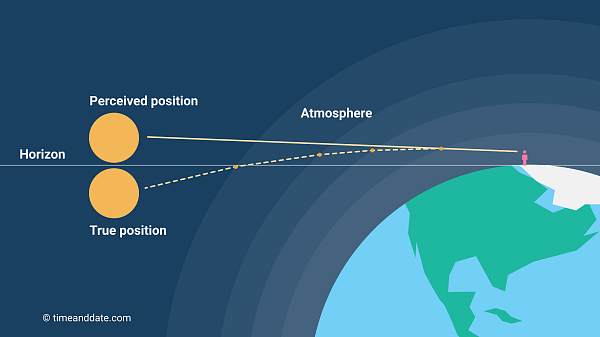What Is Refraction of Light?
Did you know that you can actually see the Sun a few minutes before it rises and a few minutes after it sets? This is because of refraction.

Refraction makes celestial objects appear higher in the sky.
©timeanddate
Magic Atmosphere
One of mother nature's favorite magic tricks, refraction is the bending of light as it moves from one substance to another.
It is responsible for a variety of optical phenomena including rainbows, mirages, halos, and sundogs. It is also the reason why stars twinkle at night, your diamond ring sparkles, a straw or pencil in water looks bent, and the Sun can be seen even when it is technically below the horizon.
The Mechanics of Refraction
How much a light wave bends depends on its wavelength, the density of the substance it is moving into, and the angle at which it hits the edge of the substance.
When light moves from a less dense to a more dense substance, like air to water or from a less dense layer of the atmosphere to a denser layer, it bends towards the normal—an imaginary line that is perpendicular to the surface of both media. The opposite occurs when light moves from a more dense to a less dense substance. The angle between the normal and the refracted light ray is known as the angle of refraction.
If light enters a medium from another substance at a 90-degree angle, it does not refract and passes right through.
Astronomical Refraction
When the light of a celestial object, like the Sun, enters the Earth's atmosphere from space, the resulting refraction is known as astronomical refraction or atmospheric refraction. This is in contrast to terrestrial refraction that occurs when the source of light is from an object on Earth.
The density of Earth's atmosphere is uneven—it decreases with increasing altitude. Light from celestial objects therefore refracts multiple times when it enters the atmosphere from space.
Astronomical terms & definitions
Displacing the Sun, the Moon, and the Stars
Light rays that travel straight down do not bend, while rays that enter the Earth's atmosphere at a shallower angle get refracted and bend towards the normal, roughly following the direction of the Earth's curvature.
This means that celestial objects in the zenith position directly above you appear in the correct position, while objects closer to the horizon appear to be higher up in the sky than they actually are.
Refraction at Sunrise and Sunset

Here, the Sun is already below the horizon. Atmospheric refraction makes the Sun visible even when it is just below the horizon.
©bigstockphoto.com/mexitographer
This effect is especially powerful for objects that appear close to the horizon, such as the rising or setting Sun, because the light rays enter the Earth's atmosphere at a particularly shallow angle. Because of refraction, the Sun may be seen for several minutes before it actually rises in the morning and after it sets in the evening.
Sunrise and sunset times in my city
One of the consequences of this effect of refraction is that, contrary to what most people think, the day and night is not exactly 12 hours long on the days of the Equinoxes. Because of refraction of sunlight, daytime is just slightly longer than night time on March Equinox and September Equinox.
This effect also has an impact on the time that the Moon can be seen before Moonrise and after Moonset.
Temperature and Pressure Affect Refraction
The extent of the refraction also depends on air temperature and atmospheric pressure: the higher the pressure and the lower the temperature, the larger the refraction angle.
So, if you watch the Sun set in an area of high pressure on a cold day, you may have to wait several seconds for the upper edge of the Sun to disappear behind the horizon, compared to a day with average pressure and temperature.
Sun Calculator Takes Refraction into Account
Our Sun Calculator takes the effect of refraction into account to deliver more realistic sunrise and sunset times for a location of your choice. Since refraction causes the Sun to appear very slightly higher in the sky, sunrise times are always a bit earlier and sunset times a bit later than they would be if our algorithm ignored refraction.
But, even so, there can be very slight deviations, depending on variations in air pressure and temperature. Our calculations are based on the standard atmospheric pressure of 101.325 kilopascals and temperature of 15°C or 59°F. If the temperature or pressure strongly deviate from the average, sunrise and sunset may happen some seconds before or after the stated time.